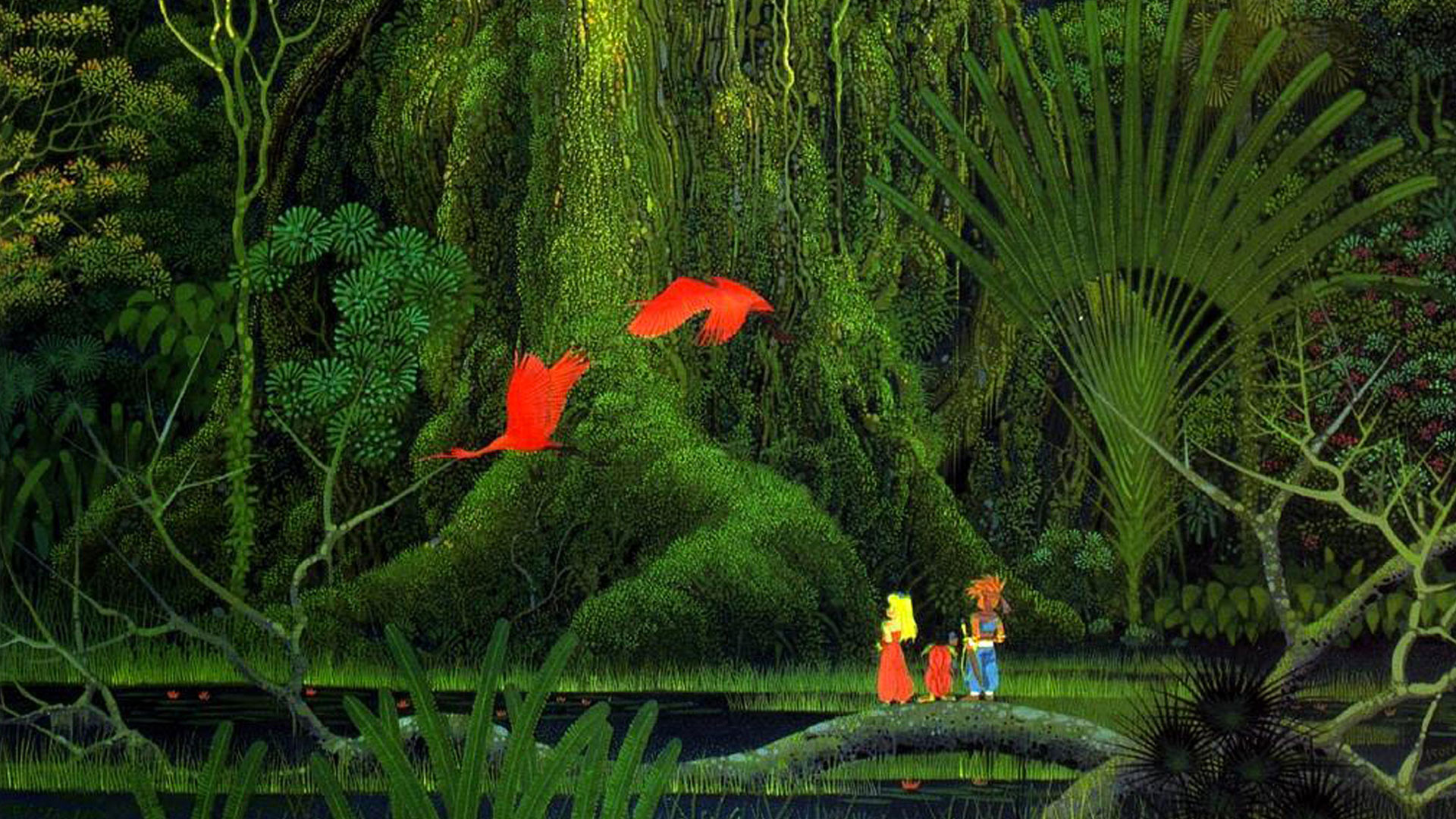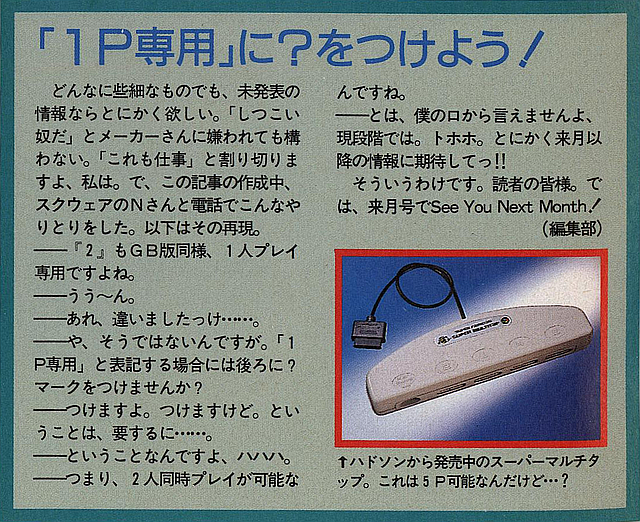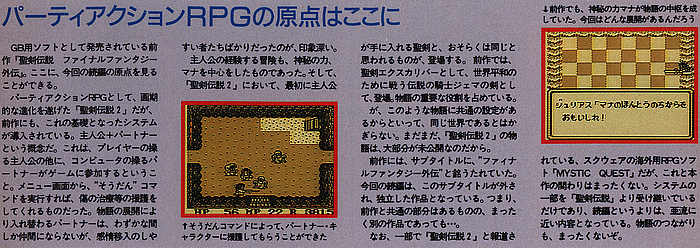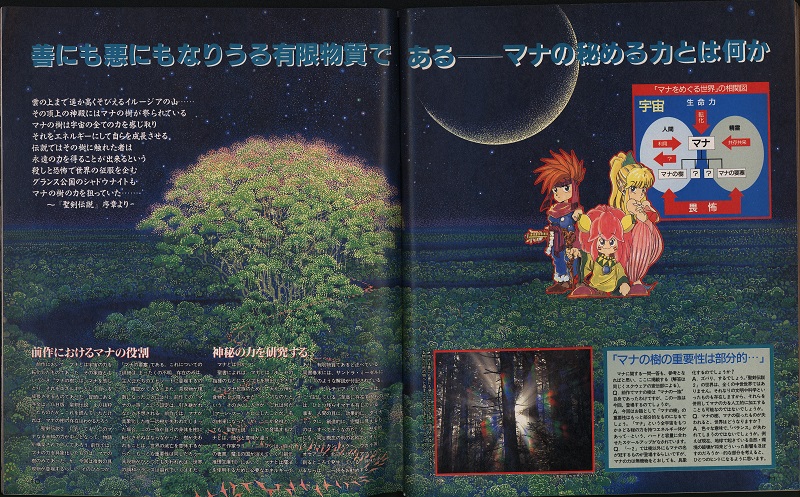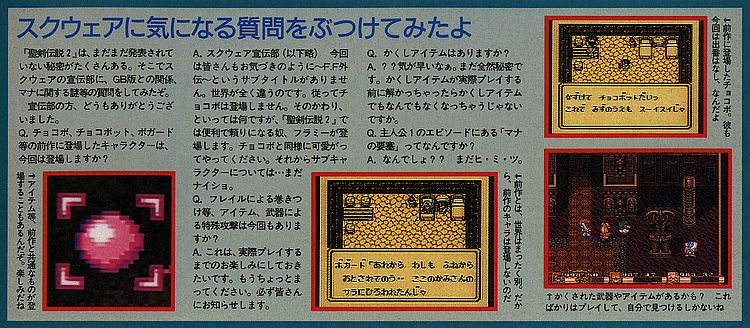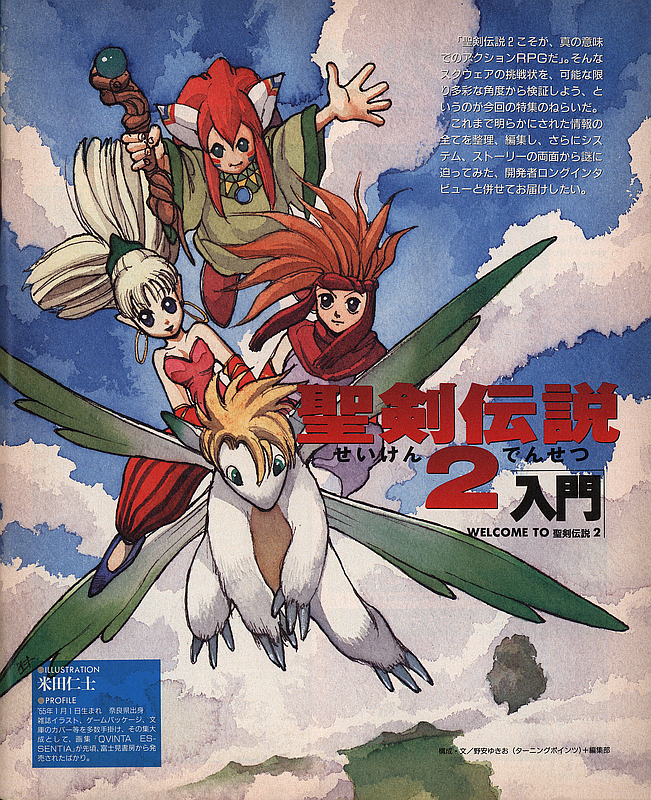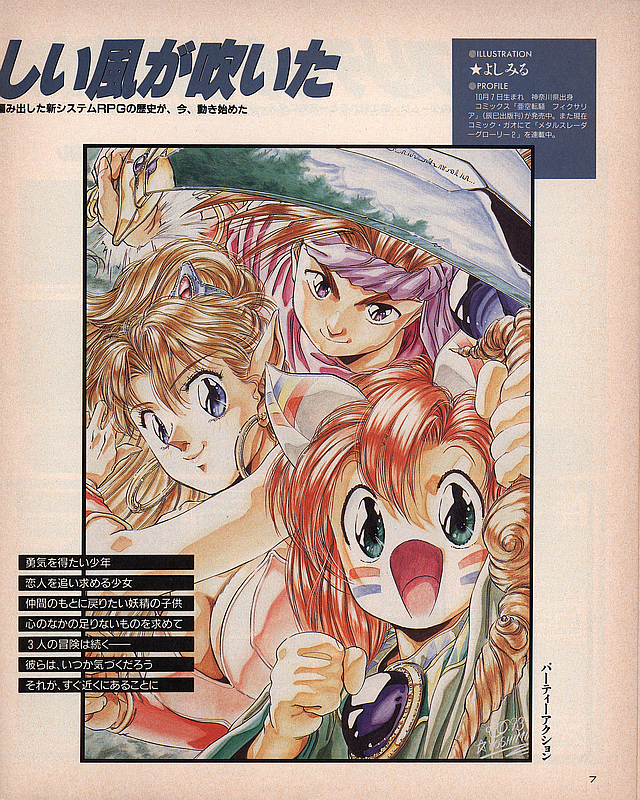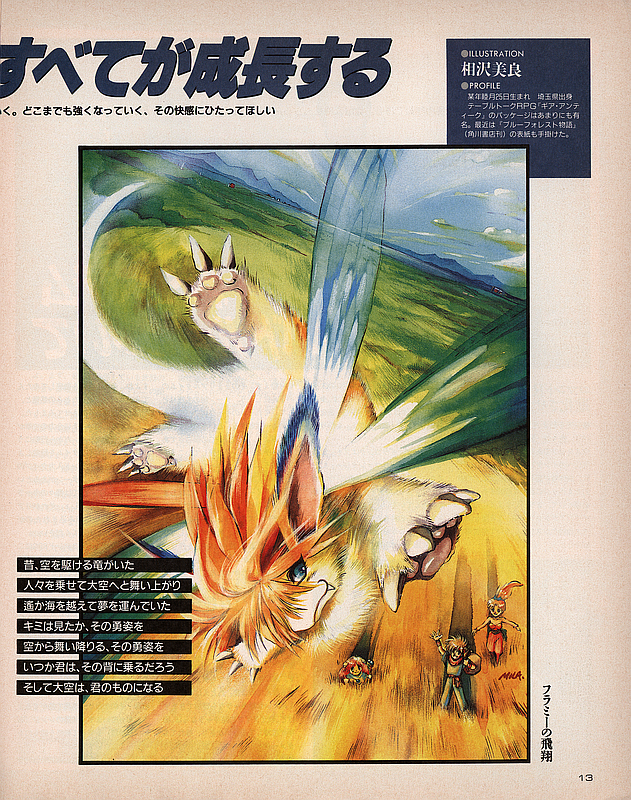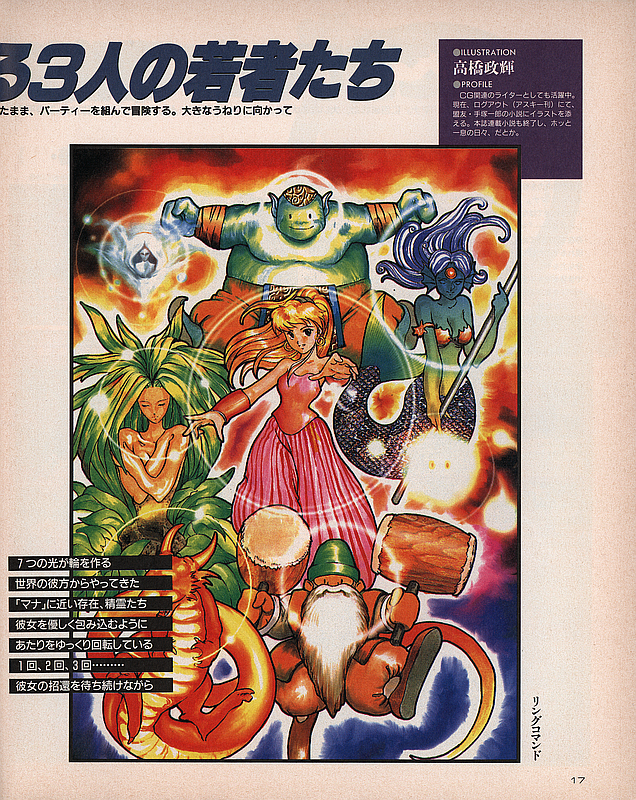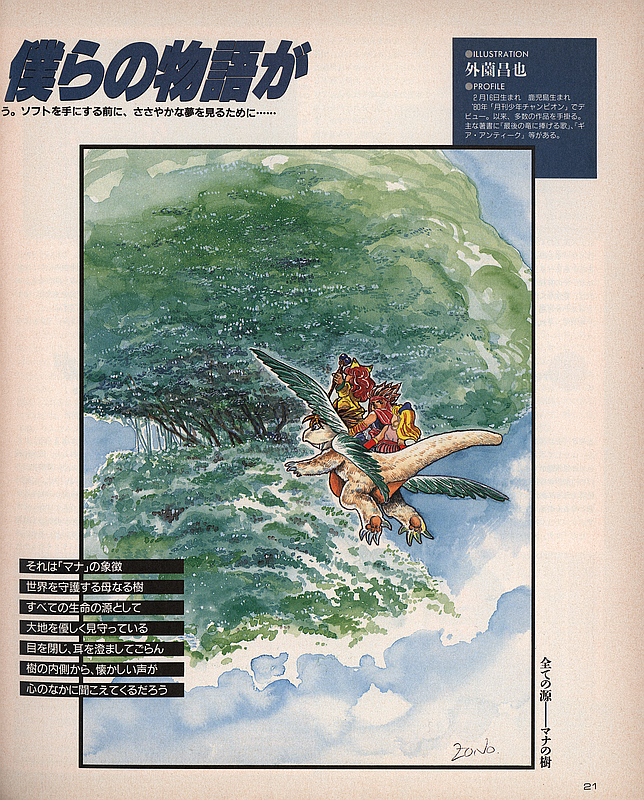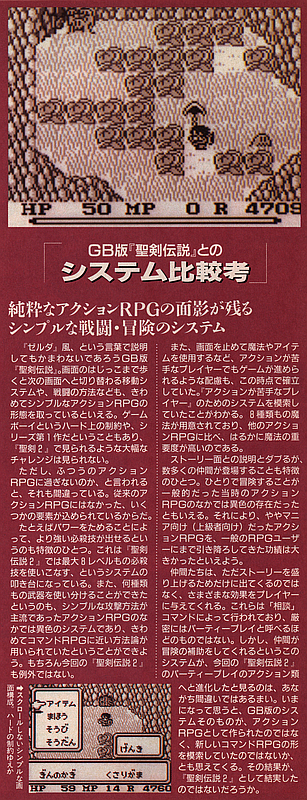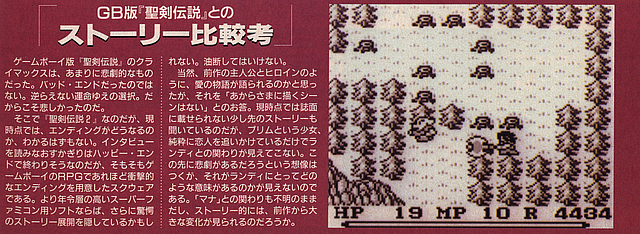Secret of Mana in Hippon Super!

Secret of Mana in Hippon Super!
May 1, 2021
Hippon Super! was published from 1991 to 1995. A lot of the best interviews and insight into Secret of Mana (Seiken Densetsu 2) was in this magazine. It was published by JICC, now Takarajimasha.
January 1993
A “Special Collectors Issue!” was published separate from the main series that clocked in at an ample 145 pages. There was a one page preview dedicated to Secret of Mana, and this section on Flammie was the talk of the magazine:
Translated by ManaRedux
The most overwhelming of the screenshots released are the Flammie flight scenes. It's a so-called "vehicle" in terms of its role [in the game], and it will [naturally] appear in the game after the middle stage. But the beautiful thing is that it makes full use of the Super Famicom's magnification/demagnification/ rotation function, and it's truly remarkable. You can freely look around 360°, move up and down, and change the viewing angle. If you remember Pilotwings, you understand the aura. Could this be enough for a whole game unto itself?
Note the early screenshots that we’ve featured elsewhere.
February 1993
Now when you invite two buddies over, the other doesn’t have to sit there awkwardly while you learn the Mana secrets.
Translated by Yoshi Fukagawa
Put a ? after "1P only"!?
I want any unpublished information, no matter how trivial it is. It doesn't matter if the [SQUARE staff] hates me as "a persistent guy". I tell myself "this is the work", [and press on]. So while writing this article, I had an exchange over the phone with Mr. N from Square as below:
Me: "2" [i.e. Secret of Mana] is also single-player [i.e. 1P] only like the GB version [i.e. Final Fantasy Adventure], isn't it?
Mr. N: (makes uncomfortable grumble like "mmmmmm", "ehhhh", etc.)
Me: Oh, it's not?
Mr. N: Well, I'm not saying it's not. If you are going to be labeling it as "1P Only", could you put "?" after that?
Me: I will. Sure I will. But, does it mean…
Mr. N: Yeah you guessed it, hahaha.
Me: So it is two-player-mode capable.
Mr. N: I can not say that at this point, unfortunately. Anyway, you can look forward to the information from next month onwards.
There you have it, my dear readers. See you in next month's issue.
(Editorial Department)
↑ Super multi-tap by Hudson. This is 5P capable.
This spread features information about the concept of Mana as it appears in the game, and how the developers arrived at their interpretation. At this point in the hype cycle, much was said in the magazine world about the connection between Final Fantasy Adventure (Seiken Densetsu) and Secret of Mana.
Translated by Yoshi Fukagawa
The previous installment, [Final Fantasy Adventure] was released for the Game Boy platform. The origin of the new release [Secret of Mana] can be seen in this [previous installment, Secret of Mana] has evolved dramatically as a party action RPG, but the previous installment introduced the underlying system of the party action RPG. It's the concept of a main player character + partner. This means that in addition to the main character operated by the player, a computer-operated partner participates in the game. From the menu screen, via the "Consultation" command, you could prompt [the partner character to take an action such as] treating a wound etc. It is impressive that it was easy to emotionally invest these partner characters even though they would only remain in the party for a short period of time due to the development of the story. In the previous installment, the main [i.e. player] character experienced the adventure centered on the mysterious power, mana. [red box caption] ↑The consultation command prompted the partner character to [use supporting actions]. Then, the main character [in Final Fantasy Adventure] acquires the holy sword which seems to be the same one that [Randi] in [Secret of Mana] acquires in the beginning. In the previous installment, [the sword] appeared as the Holy Sword Excalibur, the sword of Gemma, a legendary knight who fights for world peace. It occupied an important role in the story. However, it is not [clear whether these two installments are set in the] same world just because there is a common setting in such a story. Most of the [Secret of Mana] stories are still unpublished...The previous installment was [treated as a side story of the Final Fantasy series]. This new installment, on the other hand, is [treated as a stand-alone work]. Meaning, although [there are some similarities between these two installments], they can be completely different [games]. [Yoshi's note: These two "holy swords" are in fact NOT the same sword because Final Fantasy Adventure and Secret of Mana were set in two completely different worlds as stated in one interview.] [second red box caption] ↓In the previous installment, the mysterious power mana was the center of the story. What kind of development will there be this time? By the way, Square's overseas RPG "MYSTIC QUEST", which is reported to be [another new installment like Secret of Mana] by some sources, is not related to this work [or the Mana series] at all. It's just a part of the system inherited from "Final Fantasy Adventure", and it's more like a sub-series than a sequel. There is no connection of the story at all.
Translated by Taosenai and Hiro Amano
Top line: A finite substance able to become both good and evil—what is the hidden power of Mana? Left: Soaring high above and beyond the clouds, Illusia Mountain… Within the sanctuary upon its summit is enshrined the Tree of Mana. The Tree of Mana takes in all the forces of the universe Turning them to energy, it enables its own growth. In the legends, it is said that those who touch that tree Can grasp the power of eternity. By murder and fear, conspiring to subjugate the world: The Shadow Knight of the Grand Dukedom, too Sought the power of the Mana Tree… ~「Legend of the Holy Sword」 From the Prologue ~ Lower Left: The Role of Mana in the Previous Game According to the previous game, Mana is something converted from the power of the universe. It can also be said that its symbolic representation is the “Tree of Mana,” which takes in Mana and uses it as energy to enable its own growth. The preceding text in the header of the page is excerpted from the GameBoy version of Seiken Densetsu, but just from reading it, you can get an understanding of the nature of the Mana Tree. Seiken Densetsu 2 will also be focused on the unknown power of Mana and will build upon its legend. In the last game, the Mana Tree was the only incarnation of the power of Mana. However, this time it seems there will be many such embodiments making an appearance. One will be the “Fortress of Mana.” All details on this matter are completely unclear. Only its existence can be confirmed, based on its appearance in the protagonists’ episode. Also, because there will be many embodiments, we can predict that the “Mana Tribe” established in the previous game will not have been able to inherit them all. In the previous game, when the single thing embodying Mana—the Mana Tree—was lost, a member of this tribe had to turn their own body into the tree, since if the tree was lost, it would mean that the world would cease to exist. This was a very important thing. If even a single embodiment was lost, the world’s balance would probably crumble. Lower left [next box]: Study of the Mysterious Power What is Mana? According to the Bible, manna is said to be “bread that was dropped from heaven by God as food for the Jewish people who were wandering the land after Moses led them out of Egypt”… At the time, the people asked aloud “man hu?” and this gave manna its name. However, even if this is where the name originated, the meaning of Mana in Seiken Densetsu has quite a different meaning. According to science fiction author Larry Niven’s work “The Magic Goes Away” [called “The Magic Country is Disappearing” in Japanese, published by Sougensuiribunko, an imprint of Tokyo Sougensha], Mana is an energy necessary to use magic, and it is specifically a limited substance. In the postscript of that book, Sandra Miesel offers the following explanation. 「… Mircea Eliade said the following: “Of all the things that exist in the [realm of the] sublime, all without exception possess Mana. In fact, all that is seen by the eyes of man as effective, dynamic, creative, and perfect are like that [have Mana]. Historically, that general notion has had other names (orenda [Iroquois], wakan [Lakota], megube [??], ugai [??] ,etc.) in Oceania, North America, and Africa …”」 If you are interested, do read the book! Right Box: Here is a set of questions and answers about Mana to be used as a reference (the answers are from Square’s advertising department). Q. In the previous game, the Mana Tree was also the Mana Tribe itself; this time, will this tribe make an appearance? A. This time, the importance of the Mana Tree will be more partial to the story. Mana is an energy that has the power to rule the entire universe… it has been scaled up in accordance with the hardware and space [of the SNES, presumably]. Q. In 2, it seems that there will be something other than the Tree that bears the name of “Mana”, but will the power of Mana flow through inorganic substances, or be embodied in other ways? A. Frankly, yes, it will. The world of Seiken Densetsu 2 is not at all a medieval world. To a certain extent there is a level of culture and science, so it would be possible to use those together to process Mana artificially. Q. If the Mana Tree and the places/things where Mana dwells are lost, what would happen to the world? A. In many different meanings, the “balance” may be lost. For example, the destruction of nature and the environment occurring in our world today—what kind of effect might that have in the future? … if you think on questions like that, they’ll serve as a hint, I think.
There was never any shortage of comparisons to Final Fantasy Adventure, the original Seiken Densetsu:
Translated by Yoshi Fukagawa
I've hit Square with my questions
"[Secret of Mana]" is still full of undisclosed secrets. So I asked Square's advertising department about the relationship between the Game Boy version [the previous installment] and the mystery about Mana. Thank you very much, Square advertising department.
Q: Chocobo, Chocobot, Boggart, and so on, will any of the characters from the last installment appear [in Secret of Mana]?
Square Advertising Department ("A" here after): As everyone has already noticed, there is no such subtitle as "FF Side Story". These are two completely different worlds. Therefore, Chocobo will not appear [in Secret of Mana]. As an alternative, in a sense, there will be the convenient and reliable Flammie in "Secret of Mana". Please care for [Flammie] as you would for Chocobo. And, about the subcharacters... I can't talk about that yet.
Q: Are there any special attacks with items or weapons, such as wrapping with the [whip]?
A: I want to [save that detail] until [everyone] gets to play. Please wait a little more. I will definitely share more information.
Q: Are there any hidden items?
A: You are impatient, aren’t you? It's still a secret. If you learn about the hidden item before you actually play, it will no longer be a hidden item, will it?
Q: What is the "Mana Fortress" which is mentioned in the episode of the main character [presumably a previous section of this feature]?
A: What do you think it is? It's a secret.
[item picture caption] Items that are common to the previous installment may appear. It is something to look forward to.
[center screen caption] The world is completely different from the previous installment. Therefore, the characters of the previous installment do not appear.
[top right screen caption] [This is the] chocobo that appeared in the previous installment. He also has no appearance this time.
[bottom right caption] Maybe there are hidden weapons and items? We have no choice but to play the game and find out ourselves.
March 1993
Translated by Yoshi Fukagawa
[Knowing] how to use special attacks was important in the previous installment For the previous installment, "Final Fantasy Adventure" for the Gameboy platform, [knowing] how to use special attacks with weapons during battle was important. Different special attacks were available depending on the weapon, and it was necessary to use them properly according to the situation. [For example], the gauge at the bottom of the screen would rise if you waited without swinging the sword, and when it was full, you could use the special attack. [This system] was well received, so it was adopted as is to Secret of Mana. [picture caption] In "Final Fantasy Adventure" for the Gameboy platform, special attacks with weapons were the key to the battle...
July 1993
The July issue had some art on the title pages, along with an extensive interview with Koichi Ishii and Hiromichi Tanaka.
More info on the FFA/SoM evolution (translated by Sevon):
Thoughts and Comparisons for [Final Fantasy Adventure] on the GameBoy: Mechanics An Action RPG with Basic Elements of Combat and Adventure One could describe [Final Fantasy Adventure] for GameBoy as a [Zelda]-like game. It has the basic elements of an Action RPG, such as walking to the edge of the screen to transition to the next area and the way combat works. Compared to [Secret of Mana], there didn't seem to be as many challenges in development since this was the first game in the series and because of hardware limitations on the GameBoy. However, calling [FFA] a regular Action RPG just feels wrong since it has many elements unseen in the genre until now. For example, there's the mechanic where charging power lets you unleash a MAX Attack. This was used as a base for the Power Attack system in [Secret of Mana], where the gauge to be charged to Level 8. Being able to use multiple weapons was also unique compared to other Action RPGs which commonly used basic attacks with a single weapon. This system very much embodies the essence of Turn-Based RPGs. [Secret of Mana] is no exception to this, of course. Another point to note is that the game pauses whenever magic is cast or items are used. This was a system specifically designed for players who might not be good at Action games. There are 8 spells and more emphasis is placed on the magic system than in other Action RPGs. One of the more unique features of the game is that other characters can join to fight on-screen and be consulted for advice. You could say it was a breakthrough since other Action RPGs typically had the player adventuring solo. This also allowed the game to be enjoyed by both Action RPG veterans and those who usually play traditional RPGs. Party members aren't there just for the sake of the story—they can also bestow various effects on the player. This is done by selecting the [Ask] command from the menu, an option not typically available when travelling with guest characters. However, it's no mistake that this system of adventuring with companions evolved into the party mechanics used in [Secret of Mana]. At that point in time, the GameBoy version of the system could be considered a new take on the Turn-Based RPG system, not something specifically designed for an Action RPG. But the results of that certainly bore fruit in [Secret of Mana]. → The screen layout is simple and doesn't scroll. Was this because of hardware limitations?
Thoughts and Comparisons for [Final Fantasy Adventure] on the GameBoy: Story The climax of [Final Fantasy Adventure] on the GameBoy was very tragic. It wasn't really a bad ending. She chose not to defy her fate. That's exactly what made it so sad. At this point, it's really hard to tell how [Secret of Mana] will end. Reading through the interview again, it doesn't sound like there will be a happy ending, but as we've seen, Square is capable of creating tragic endings for a GameBoy RPG of all things. Now that they're using the SNES hardware, who knows what kind of secrets they'll be hiding. Don't let your guard down. It seemed natural that the hero and heroine from the previous game would fall in love, but there weren't any scenes actually showing this happening. Parts of the story for [Secret of Mana] can be gleaned from the other pages in this magazine, but it's hard to imagine a girl like Purim simply chasing after her lover, much less what her connection to Randi could be. There will probably be some sort of tragedy like in the previous game, so what does this mean for Randi? The connection to [Mana] has yet to be seen, but the story looks to be completely different this time around.

